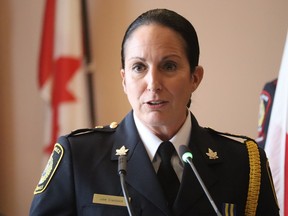
Auxiliary officers could be helping with everything from community events and impaired driving checkpoints to front-line policing by May, Sarnia’s deputy police chief says.
Advertisement 2
Article content
Training starts in January on use of force, Criminal Code, Highway Traffic Act and other aspects of regular officer training, just less in depth for the volunteers who won’t carry firearms, but will have the same authority as regular officers when directly supervised by police, said Julie Craddock.
Article content
“We’re excited to have them,” she said of the six applicants who recently cleared police vetting, including physical testing, interviews and background checks.
“We have what we believe to be a really good training plan in place for them to make sure that they have the skills they need to be able to fulfill those auxiliary policing duties.”
The new auxiliary unit was part of a 2022 police plan to increase aspects of the service that also included boosting mental health supports and co-ordination with social service agencies.
Advertisement 3
Article content
The idea was to have 10 auxiliary officers to startbut a few dropped out for other opportunities, including one hired as a police officer by another department, Craddock said.
A graduation ceremony for the recruits, who received their uniforms and equipment — they carry handcuffs and batons, but not stun guns or firearms — is expected in April, she said, noting one will be the unit’s sergeant.
The service had hoped to have the auxiliary unit in place by the fall, but there were delays linked to provincial rules for more frequent intakes at the Ontario Police College, Craddock said. “We had to have officers hired and do their pre-Ontario Police College training in a different timeline than what we were used to,” she said.
Advertisement 4
Article content
They also took time to get the process right, Craddock added. “We had to make sure we have the right candidates.”
The people offered auxiliary posts are “really great,” she said, adding those who “volunteer in a policing organization are there for the right reasons (and) share that commitment to public safety that we all have.”
While the service can accommodate as many as 20 auxiliary officers, plans are to see how it goes with six first, Craddock said.
Hopes are to get feedback and make adjustments before looking to expand, she said, but recruitment could resume as early as next fall for possible training in January 2025.
Sarnia police laid about 110 impaired driving charges in a little more than 11 months in 2023 – about the same as in previous yearsbut it could be higher, Chief Derek Davis said recently.
Advertisement 5
Article content
That’s because the number tends to increase when police dedicate more time to things like Reduce Impaired Driving Everywhere (RIDE) checkpoints, but there’s been little opportunity because other calls take priority, he said.
“When officers are being deployed to emergency response, the thing that generally falls off is that proactive police work,” such as traffic enforcement and road safety, Craddock said.
The former Halton Regional police inspector says helping out with RIDE checkpoints has been a major focus for other auxiliaries she’s worked with.
Sarnia police RIDE programs require five officers to run, she said. But that drops to two if three auxiliary officers can step in.
“They’re always under the supervision of an officer, but it just gives you more capacity when you have more people,” she said.
Article content